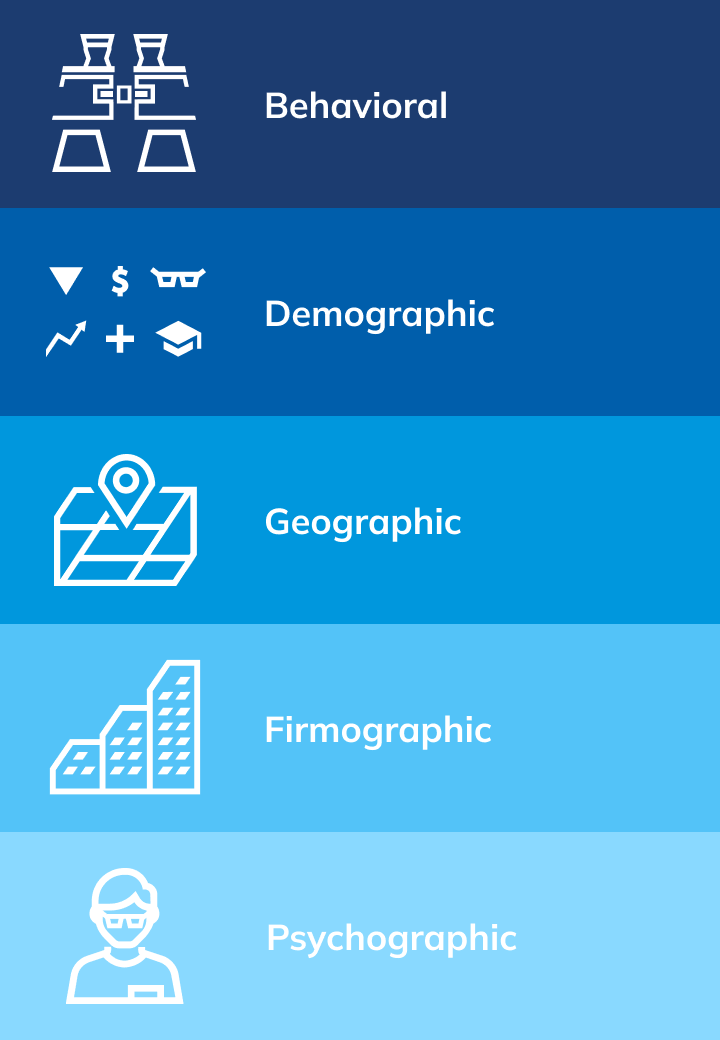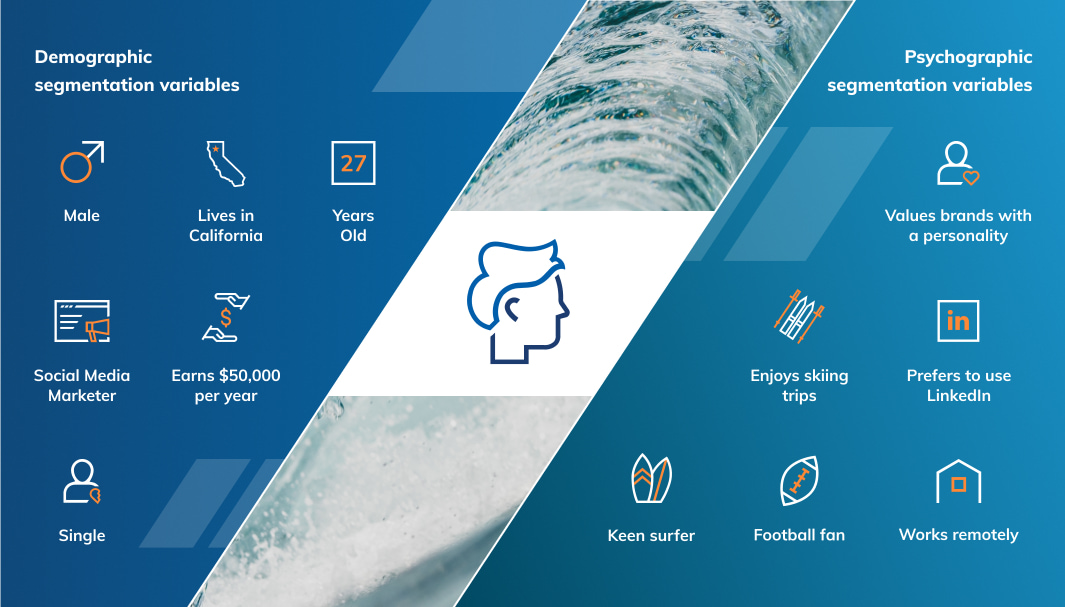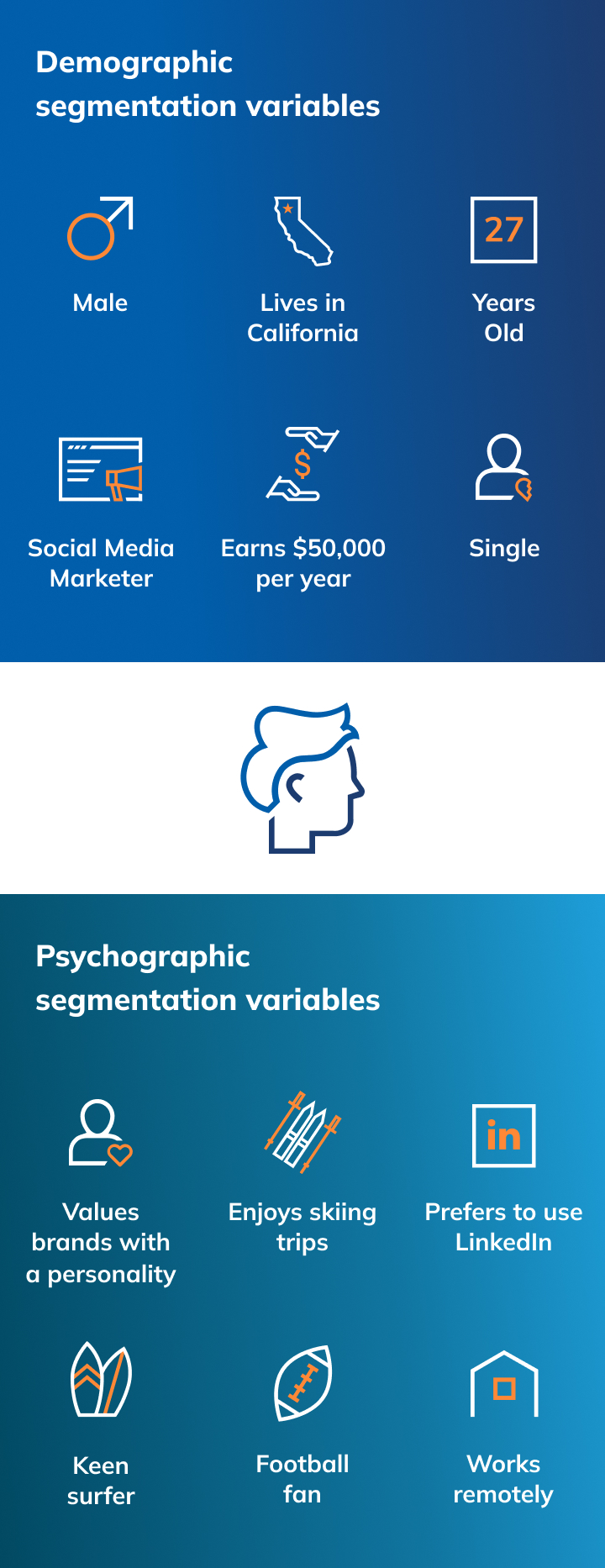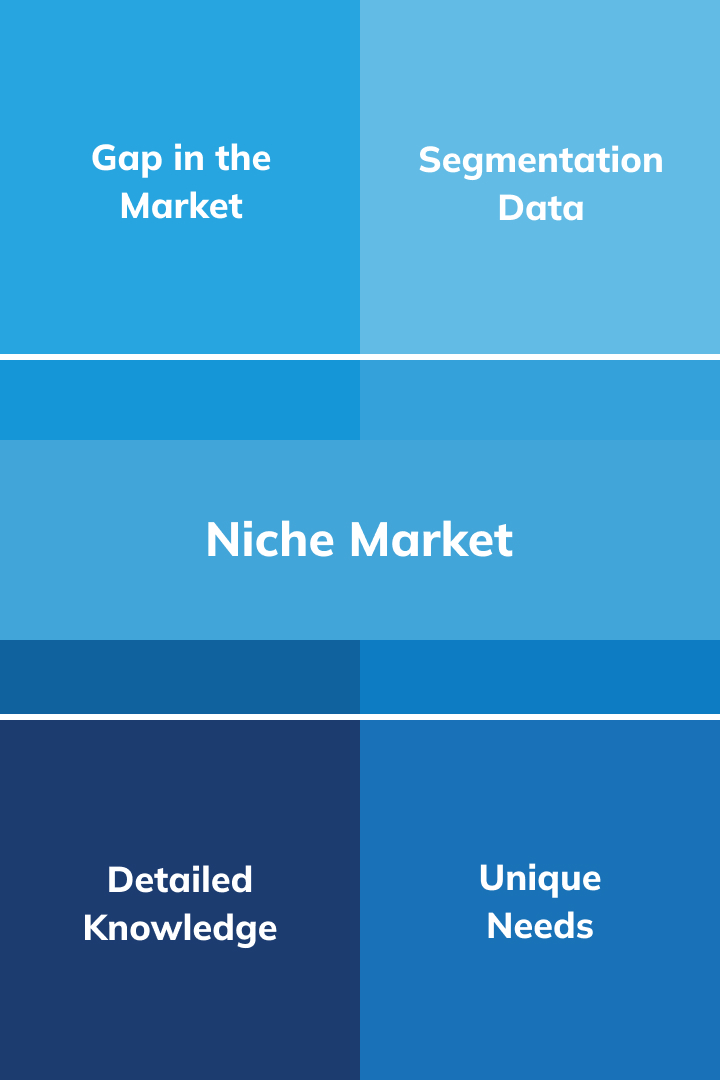Definitive Guide
to B2B Market Segmentation
What is B2B Market Segmentation?
With the rise of data-driven marketing and the death of the hard sell, B2B market segmentation is essential to ensuring that sales and marketing campaigns yield positive results. Personalization is highly valued by today’s prospects and is a complex process to implement successfully that can be initiated and informed with effective market segmentation.
Types of B2B Market Segmentation
B2B Market segmentation definition:
What is market segmentation?
Market segmentation is the process of dividing a market into smaller groups of consumers with similar needs, interests, or characteristics. By doing this, businesses can create more targeted marketing campaigns that are tailored to the specific needs of each group. For example, a company that sells sports equipment might segment their market into different groups based on age, gender, income, or location.
The purpose of B2B market segmentation (also known as marketing segmentation) is to assist marketers to accurately identify key groups of potential buyers based on factors such as location, buying behavior, or personality and interests.
The most effective campaigns using target market segmentation employ multiple methods to develop accurate groupings of potential leads. A detailed market segmentation process allows for segmentation marketing and for sales campaigns to be strategized in a manner that ensures greater efficiency in attracting and appealing to the target audience.
Personalization is crucial to successfully relate to prospects and influence buyer groups, but it can be a complex process to implement successfully.
Through a detailed segmentation strategy marketers can better understand the needs and business goals of clients and, as a result, tailor products and services more accurately. Messaging will be more on point and impactful and opportunities for growth maximized, while also maintaining budgetary efficiency.
This method can also help B2B marketers identify and make gains in new or emerging markets by ensuring highly relevant campaigns make businesses the preferred choice for key groups in those markets. By the same merit, more relevant campaigns promote client retention and nurture the longer-lasting personal relationships typical of B2B by reminding existing partners of the solutions your business can provide.
With proper marketing segmentation strategies, companies can drive up the success of their marketing and sales campaigns while nurturing and growing target markets in a manner that encourages a positive ROI and increased revenue.
As B2B marketers, it is crucial to understand the fundamentals of demand generation and how to develop interest and awareness of your brand.
In our Definitive Guide to B2B Demand Generation we explain in depth how to design and implement successful demand generation campaigns.
What is Marketing Segmentation?
Marketing segmentation, on the other hand, is the process of dividing a market into smaller groups of consumers based on their behavior or responses to marketing messages. This approach is often used to target customers who have already shown an interest in a particular product or service. For example, a company might segment their market based on whether customers have visited their website, opened an email, or made a purchase.
Five Types Of Market Segmentation Strategies - How to Segment a Market
Effective B2B market segmentation can be achieved via a variety of techniques to gather and determine insightful information.
Each type of segmentation strategy focuses on different variables that can be used to define key groups within target markets and guide B2B campaigns. As such, every strategy should be tailored specifically to the project in hand to create not just detailed but accurate buyer profiles.
It can be effective to utilize a combination of market segmentation methods and a myriad of data variables to create a complete picture of prospects, their respective organizations, and how they can be organized. Here are some target market segmentation examples below:
Example of Insights From Market Segmentation For Social Media Content Creator
As demonstrated in the infographic above, each B2B segmentation method reveals different insights about prospects, their business goals, their company, and factors that may potentially influence a final purchase decision. This data can be interpreted to create specific groups and targeted strategies.
Below, we explore each form of segmenting target audiences in greater detail.
Behavioral Segmentation
Behavioral market segmentation methodology focuses on the behavior of an existing client base through analysis of first-party data typically collected from proprietary websites.
By measuring how clients behave during extended purchase periods and longer B2B personal relationships, B2B marketers can learn how to address the needs and desires of different segments more comprehensively. In other words, measuring behavioral patterns allows marketers to predict the future by examining the past.
Behavioral market segmentation examples:
Instead of wasting resources chasing dead end accounts, the behavioral data collected through segmentation can ensure campaigns target more qualified leads that have often indicated buyer intent through their actions.
This means streamlining efforts by focusing on the most valuable accounts that are more likely to benefit from, and respond to, the products and services being offered.
Marketers can use this data to determine the preferred channels of communication through which to contact target markets and reach buyer committees. Identifying the best channels to publish on is an essential component of creating a personalized campaign.
Marketers can also analyze behavioral data to ensure that content and communications reach prospects on the right day of the week and at a time when they are most receptive.
In short, behavioral market segmentation is highly informative and can provide insights that go beyond static variables and aid targeted outreach to organizations. However, due to its fluid nature, it is important to consistently measure data and adjust campaigns accordingly to keep pace with changing trends and avoid irrelevance.
Demographic Segmentation
Demographic market segmentation is largely considered to be the starting point for B2B segmentation strategies and serves to break down target markets into broad categories that can be refined later.
Demographic market segmentation examples:
Demographic data is simple to record and due to its static nature, is generally more stable than other data types, plus the type of information it provides is often actionable.
For example, annual income data can be used to quickly segment target accounts into identifiable groups that share common characteristics, in this case purchasing power.
Marketers can use this information to avoid wasting time and resources by targeting low-income prospects that are unlikely to become buyers or prospects who are unlikely to influence a buying decision.
This approach is fundamental to ensuring that each campaign’s core messaging is personalized correctly. Demographic segmentation marketing also paves the way for further segmentation of leads into more detailed subcategories with the introduction of additional variables.
Geographic Segmentation
Geographic market segmentation refers to and deals with the ‘where’, categorizing prospective clients based on their location.
Geographic market segmentation data includes:
Easy to identify and implement, geographic segmentation provides marketers with important insights that can influence or limit human behavior and inform campaigns, such as changing seasons, the geo-political landscape, geographical and location-based restrictions, and cultural identity.
Combined with additional data, B2B marketers can leverage geographic segmentation information to ensure campaigns don’t just connect with target audiences on a meta-physical level, but also a practical one. And data can be gleaned at various levels of detail, from broad to granular depending on the needs of each campaign.
The influence of location is important to consider when building strategies and campaigns to reach prospects effectively as it may contribute to external factors that affect a buying group’s decision-making. Although one of the simplest data sets to acquire, segmenting by geography can nevertheless provide important information that might otherwise be overlooked.
Firmographic Segmentation
What Is Firmographic Segmentation?
Firmographic market segmentation data refers to the analysis of whole industries and the companies which operate within them to determine whether they have the potential to become high-value clients.
In the same way that demographic segmentation categorizes individuals into larger groups with defining characteristics, firmographics serves much the same purpose but at a company level.
Firmographic market segmentation examples:
By focusing on these variables B2B marketers can develop a better understanding of which companies provide more investment potential, then create campaigns to fit. It can also be used to identify individuals within a specific company as points of contact on a buying committee, meaning campaigns can be personalized more effectively.
Once successful strategies have been implemented for specific companies, marketers can use firmographic information to help identify similar companies, even entirely new target markets, and ensure subsequent marketing strategies are optimized, and personalized, for those markets.
Psychographic Segmentation
As buyers continue to expect and respond better to highly personalized marketing and sales campaigns, the analysis and implementation of psychographic data is crucial. Prospects want to be understood and to be approached in a way that communicates on their level.
As a result, integrating psychographics into target market segmentation strategies helps B2B marketers identify and profile individual personas primarily through the focus on IAO variables (interests, activities, and opinions). The intention here is to relate to potential clients on a deeper, more personal and cognitive level.
Psychographic segmentation examples:
Demographics vs. Psychographics
Data can be collected from existing or potential clients via a variety of different channels such as social media interactions, web analytics or direct interviews.
Like behavioral segmentation, psychographics can help identify those channels through which prospective clients are most likely to be receptive to messaging. Together with timing and frequency, it is an important data set that can assist with optimizing the outreach of campaigns and better understanding external factors that influence buyer decisions.
Essentially, psychographic segmentation provides B2B marketers with the means to appeal to prospective clients and their emotional triggers in a way that makes them feel valued and encourages them through the sales funnel.
Each prospect and the organization that they represent has different ideals, aspirations, and views that if understood, can be leveraged to encourage them through the sales funnel.
For more detail on psychographics, read our Definitive Guide to Marketing Psychographics.
INFUSE’s team of demand experts will analyze your strategic needs and develop a market segmentation strategy that delivers results for your demand generation campaigns.
Book your 30 Minute Market Segmentation strategy call here
How Market Segmentation Influences The Four Ps of Marketing
Before attempting to market and sell a product or service, companies first need to determine its characteristics and features, who they can sell it to, and how much it is worth.
This is where practical know-how meets industry application as target market segmentation strategies and knowledge of how to segment a market can be used here to inform and inspire strategies across the four main pillars of B2B marketing, incorporating product creation, pricing, placement, and promotion.
1. Product
This is what a company sells, and the creation of a product or service requires a great deal of knowledge about the market in which it will be sold. Typically, a successful product will be modeled on existing and potential demand indicators or by providing an innovative solution to a commonly experienced problem.
Discover key indicators for forecasting demand.
At this stage the most important aspects to consider are how the brand is displayed, the packaging of the product or service to the right clients, and the product or service itself.
Market segmentation can provide the deeper level of data needed to create a product that is unique and offers genuine value in the marketplace, and appeals to a specific need that resonates with decision-makers within target accounts.
2. Price
The most important aspects of pricing are the offer price, available promotions, and discounts.
Establishing the prices of products and services requires multiple variables to be taken into consideration. As products have real and perceived value, companies need to consider the buying power of organizations with target markets and proceed accordingly.
These decisions can be informed using firmographic and demographic data with variables like target market size and company budgetary restrictions. After all, prices need to be competitive yet profitable and reflect the value of the product itself.
Some brands charge higher fees for similar products to those provided by competitors yet maintain consistent levels of sales. Some see a high price as reassuringly expensive, while others will be put off and explore more cost-effective solutions.
It all depends on the strength of the brand. If the brand is well known for high quality products, then clients may often be willing to pay a premium. Data of the sort provided by segmentation will also be at a premium when it comes to making the right pricing decisions and marketing prices in line with the needs and business goals of target accounts.
3. Place
In the international B2B marketplace, the place or location of your product is as relevant as ever, even for online or multi-national companies that operate on a global scale.
More often than not, companies must identify where their clients are and go to them. Not the other way around. Geographic segmentation data is therefore crucial in this respect.
Place takes into account not just a physical location in the real world, but also which channels potential clients use, which local markets are ripe for growth, and which are already dominated by a competitor.
Upon learning a target market is already crowded marketers can turn their attention elsewhere, saving time and resources.
4. Promotion
The promotion of products and services is integral to sales.
Psychographic and behavioral segmentation data, in particular, can prove to be especially insightful. Understanding buyer personas, behaviors, and buying habits, like those generated with more qualitative segmentation strategies, is critical for the creation of successful content marketing strategies.
Market segmentation theory and data can also be used to identify the correct channels through which to reach decision-makers and distribute content, as well as to inform which formats are proving to be most popular.
As target audiences respond differently to the methods companies use to promote their product or service across their chosen channels, developing informed strategies with market segmentation data can help deliver a positive ROI.
Online tools such as Google’s SimilarWeb platform offer ways for companies to track promotional KPIs such as traffic, engagement rate, keyword ranking, and more for any website, including competitors’.
Definitive Guide to B2B Demand Generation.
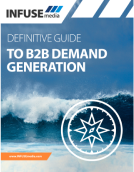
Buyer Personas
Creating a Buyer Persona
Buyer personas are semi-fictitious marketing profiles created using data on existing and potential clients to help determine their behavior, develop a better understanding of their needs and what kind of content they respond well to.
As such, buyer personas serve as another tool for segmenting target markets and are essential for any B2B company planning to or already running an ABM campaign.
Due to their artificial nature, detailed buyer personas need to be constructed from a variety of reliable, qualitative data sources, and which can then be used to inform subsequent marketing and sales strategies.
But beware, they can backfire if the requisite care is not taken. Due to their fluid nature, buyer personas require constant adaptation and perfecting to ensure they provide marketers with the right approach.
Failure to address leads in the right way will lead to wasted investment and greater churn as they reject clumsy advances and look for alternative, more attentive providers.
Buyer personas are a useful method through which to connect with prospects on a deeper, more personal level and serve as another example of how effective marketing segmentation can provide more power to campaigns.


Product Positioning
Product positioning is the strategy of crafting how target markets respond to your product or service.
To get this right, companies need firstly to evaluate the market and decide where they can sell for maximum effectiveness, or in other words, who will most likely benefit from their solutions. And secondly, to communicate effectively to that target market.
Trying to build a brand with a broad appeal is a risky strategy, initially. There is rarely an ideal solution for multiple partners that isn’t bespoke, so by trying to appeal to everyone companies chance poor ROI by creating a strategy that fails to appeal to anyone.
Remember, the objective of product positioning is to make a product or service as attractive as possible for your target market. It is not a tangible thing with a finish line, but instead a steady process of brand building to ensure people think about your business in a positive way.
Typically, there are two important points to consider:
Product positioning can be informed by a variety of market segmentation strategies to determine important details, not just about the target market, but also about rival products. It would be a waste of time, for example, for a digital start-up to begin challenging Google for advertising space.
Indeed, part of the process for positioning products competitively requires research on current competitors and their strategies. A clear understanding of the competition is vital.
By leveraging information from segmentation and buyer personas, marketers can decide how best to ensure products resonate with prospective clients. Using psychographic data, for instance, might give one company the edge in its products arms race. And those companies which scrape sales and outlast their rivals may find the market suddenly opens up when other companies go out of business.
To successfully position products and services companies must ensure that they know and understand their clients, have analyzed their competitors and are able to effectively communicate the uniqueness of their own brand.

Niche Marketing
The principle of niche marketing is to promote and sell a product or service to a specific, often smaller, and unique section of the market. This process starts by identifying and categorizing potential clients that form the consumer base and who might be unique in terms of goals, outlook, or demand.
Niche Markets
Niche markets can typically be defined by using the following B2B segmentation methods and other data categories:
The whole point of identifying niche markets is to enable companies to micro-market and target their product or service to an often smaller, more nuanced client base which might otherwise make lead generation challenging.
Accuracy is crucial for ensuring that campaigns are personalized effectively, with language, tone and style important variables to get right.
As a result, niche marketing strategies can really benefit from the level of detail provided by market segmentation, in particular the more qualitative data afforded by psychographics and behavioral research.
For example:
- Firmographics can be used to determine which organizations within a niche market offer the most potential, as well as who best to contact within those companies by providing insights into individuals who may sit on a buyer committee.
- B2B psychographic segmentation can identify the distinguishing human characteristics of niche markets which can later be leveraged to determine the preferred channels of communication, together with the right language and style to employ to optimize personalization and outreach.
- Geographic segmentation at a granular level can be utilized to identify niche markets and guide personalization by adjusting to location-based factors influencing decision processes.
Having analyzed and defined target niche markets, companies can employ predictive analytics to forecast future trends and behaviors, opening up yet more opportunities for growth in otherwise restrictive territory.
To get the most out of any niche marketing strategy requires continuous research and testing to ensure that campaigns remain effective over time and that products are positioned correctly.
It can often be a time-sensitive operation in which companies need to respond quickly to changes to avoid missed opportunities. Or worse, to become irrelevant.
Benefits of nailing down a niche market typically include higher brand loyalty, higher prices due to specialization, higher profit margins on individual items, and less competition. Negatives include smaller, more nuanced consumer bases and lower total profits, while some niche markets may be vulnerable to external influences, like fashion, which can affect greater competition or a reduction in the consumer base based on social trends.

Conclusion
For modern B2B marketing and sales strategies to reach and influence decision-makers on buying committees to be successful, companies can no longer get away with being uninformed or creating campaigns which fail to communicate on the right level. Personalization is oh so important and anything less is likely to fail to influence buying decisions and be ignored.
As such, the depth of detail generated via a multitude of B2B market segmentation methods concerned with the needs, aspirations, interests, opinions, locations, buying power, and tone of content and the preferred channels of communication of target audiences is invaluable.
Realistically, companies cannot successfully plan ahead without it.
With a myriad of lead generation and demand generation tools and services at our disposal, we can help you get the result you are looking for.
Let’s build successful strategies for your business together. Contact the team at [email protected].


